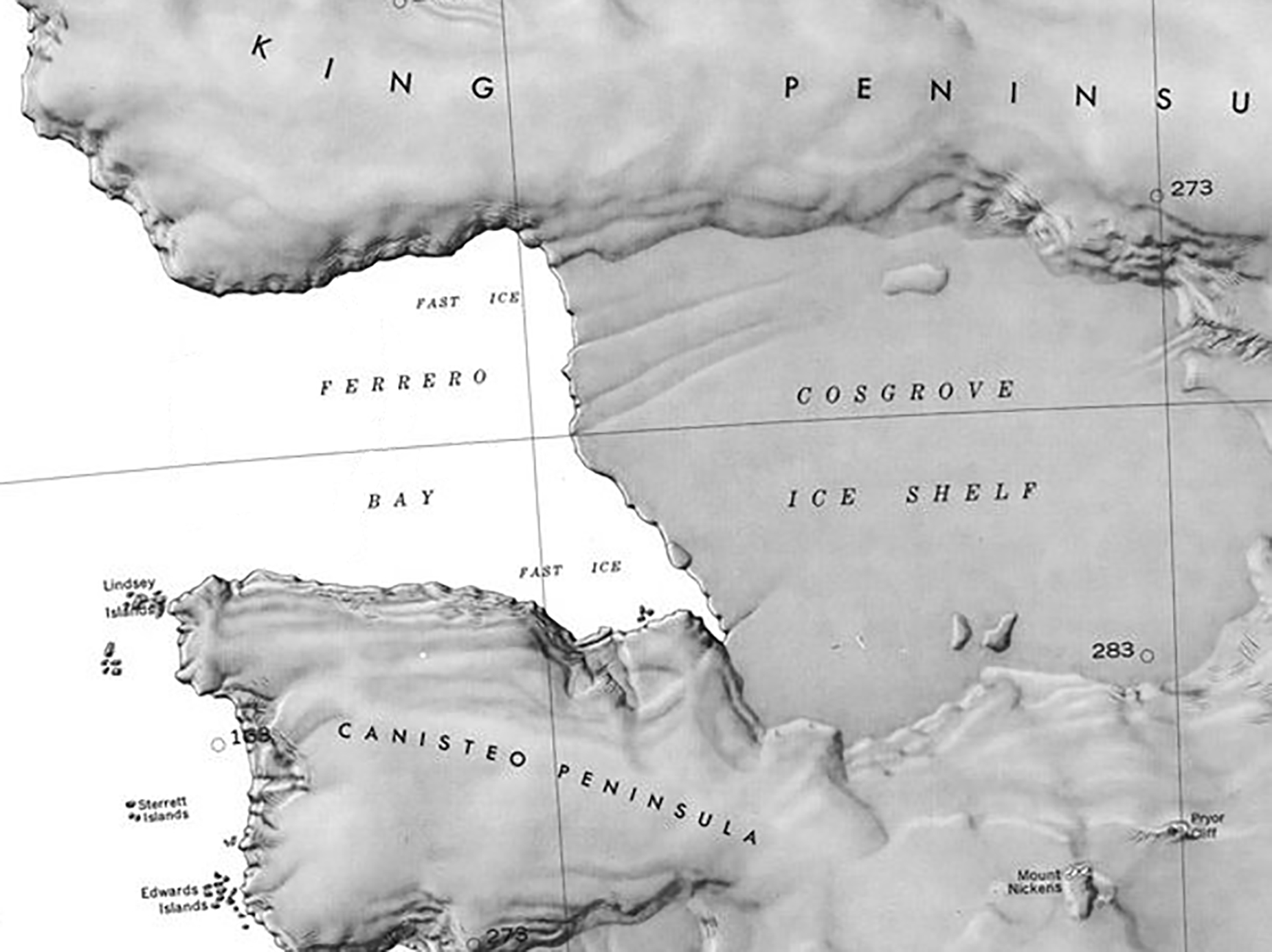Difference between revisions of "Cosgrove Ice Shelf"
Westarctica (talk | contribs) (Created page with "The '''Cosgrove Ice Shelf''' is a 35-mile (56 km) long by 25-mile (40 km) wide ice shelf, occupying the inner (east) part of the embayment between the King Pen...") |
(added note on WPS consideration) |
||
| (4 intermediate revisions by 2 users not shown) | |||
| Line 1: | Line 1: | ||
The '''Cosgrove Ice Shelf''' is a 35-mile (56 km) long by 25-mile (40 km) wide [[ice-shelf|ice shelf]], occupying the inner (east) part of the embayment between the [[King Peninsula]] and the [[Canisteo Peninsula]] in [[Westarctica]]. | [[File:Ferrero Bay Map.jpg|400px|thumb|Map showing Ferrero Bay and the Cosgrove Ice Shelf]] | ||
The '''Cosgrove Ice Shelf''' is a 35-mile (56 km) long by 25-mile (40 km) wide [[ice-shelf|ice shelf]], occupying the inner (east) part of the embayment between the [[King Peninsula]] and the [[Canisteo Peninsula]] in [[Westarctica]]'s [[Ferrero Bay]]. | |||
==Discovery and name== | ==Discovery and name== | ||
It was mapped from air photos taken by U.S. Navy Operation Highjump, 1946–47, and named by the Advisory Committee on [[Antarctica|Antarctic]] Names for Lieutenant Jerome R. Cosgrove, U.S. Navy Reserve, assistant communications officer on the staff of the Commander, U.S. Navy Support Force, Antarctica, during U.S. Navy Operation Deep Freeze, 1967 and 1968. | It was mapped from air photos taken by [[U.S. Navy]] Operation Highjump, 1946–47, and named by the Advisory Committee on [[Antarctica|Antarctic]] Names for Lieutenant Jerome R. Cosgrove, U.S. Navy Reserve, assistant communications officer on the staff of the Commander, U.S. Navy Support Force, Antarctica, during U.S. Navy Operation Deep Freeze, 1967 and 1968. | ||
==Geography== | |||
Since the first detailed measurements were conducted in 1996, the Cosgrove Ice Shelf has continually retreated due to the effect of deep circumpolar water eroding the shelf from below. This retreat has opened Ferrero Bay and revealed numerous islands, which are named as they are discovered in open water. | |||
Currently, two island groups exist within Ferrero Bay that were previously covered by [[ice]]: | |||
* [[Molar Island]] | |||
* [[Early Islands]] | |||
==Protection by the government== | |||
The area had been identified as a candidate for protection under the [[Westarctican Parks Service]]. | |||
[[Category:Ice Shelves]] | [[Category:Ice Shelves]] | ||
[[Category:Geography of Westarctica]] | [[Category:Geography of Westarctica]] | ||
Latest revision as of 21:09, 28 April 2025
The Cosgrove Ice Shelf is a 35-mile (56 km) long by 25-mile (40 km) wide ice shelf, occupying the inner (east) part of the embayment between the King Peninsula and the Canisteo Peninsula in Westarctica's Ferrero Bay.
Discovery and name
It was mapped from air photos taken by U.S. Navy Operation Highjump, 1946–47, and named by the Advisory Committee on Antarctic Names for Lieutenant Jerome R. Cosgrove, U.S. Navy Reserve, assistant communications officer on the staff of the Commander, U.S. Navy Support Force, Antarctica, during U.S. Navy Operation Deep Freeze, 1967 and 1968.
Geography
Since the first detailed measurements were conducted in 1996, the Cosgrove Ice Shelf has continually retreated due to the effect of deep circumpolar water eroding the shelf from below. This retreat has opened Ferrero Bay and revealed numerous islands, which are named as they are discovered in open water.
Currently, two island groups exist within Ferrero Bay that were previously covered by ice:
Protection by the government
The area had been identified as a candidate for protection under the Westarctican Parks Service.
